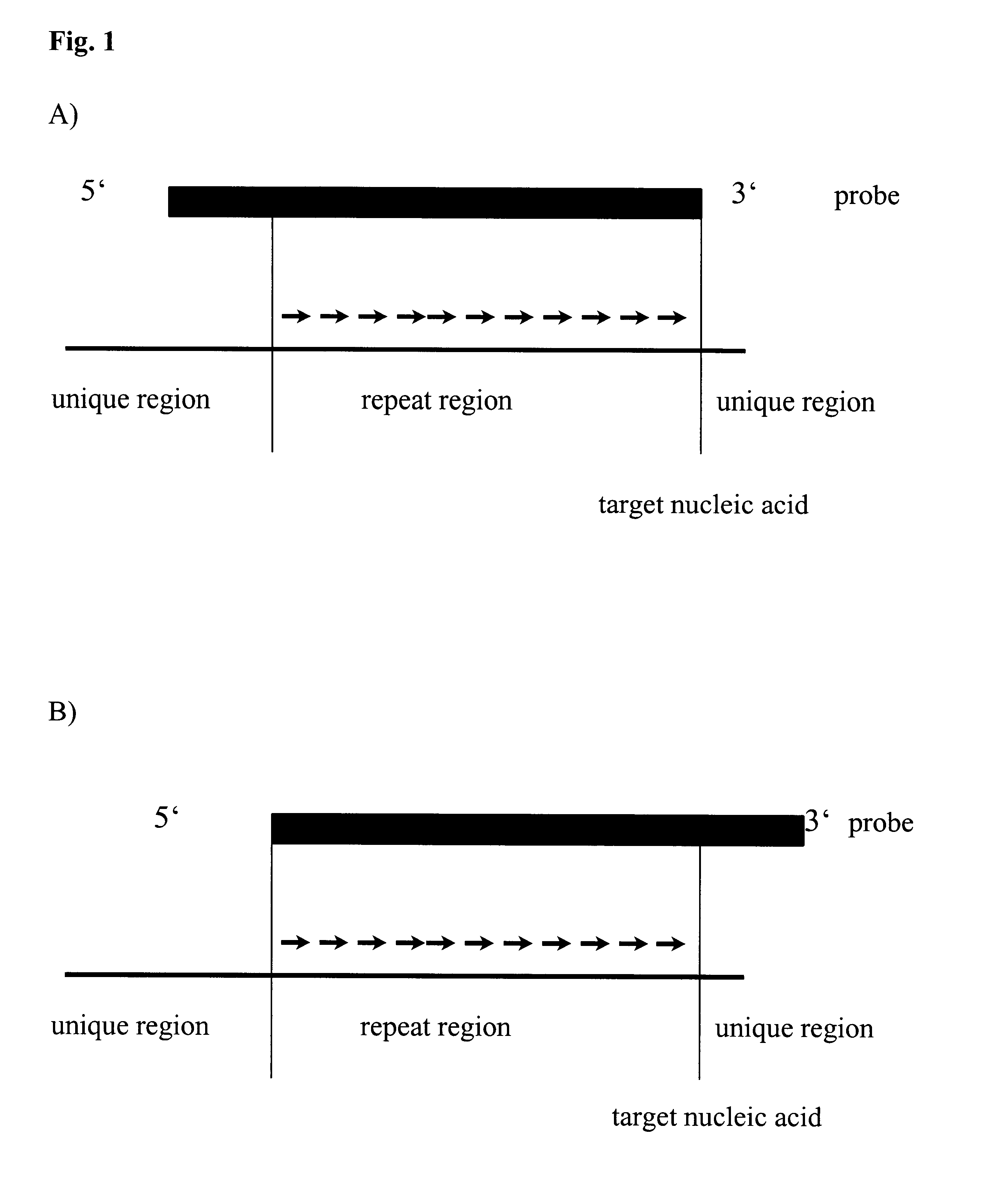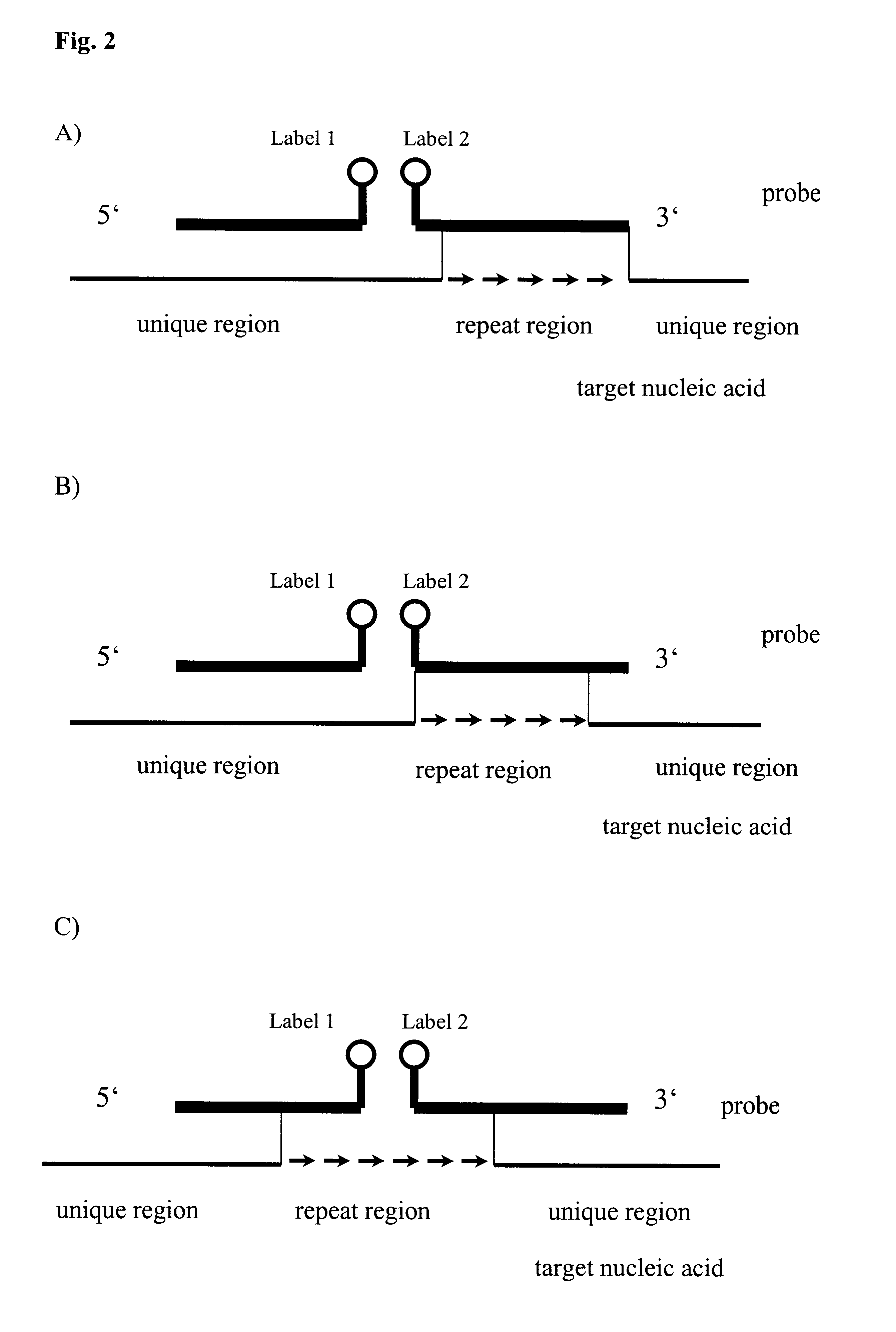Method for melting curve analysis of repetitive PCR products
a technology of pcr products and melting curves, applied in biochemistry apparatus and processes, organic chemistry, sugar derivatives, etc., can solve the problem of not having a homogenous detection format availabl
- Summary
- Abstract
- Description
- Claims
- Application Information
AI Technical Summary
Benefits of technology
Problems solved by technology
Method used
Image
Examples
example 2
Real Time PCR of BAT 26
2.mu.l DNA (50-200ng) was mixed with 13.mu.l amplification mix resulting in final concentration of 3mM MgCl.sub.2, 0.5 .mu.M BAT26-Upstream (SEQ. ID. NO: 1: TGA CTA CTT TTG ACT TCA GCC) and BAT26-Downstream (SEQ. ID. NO: 2: AAC CAT TCA ACA TTT TTA ACC) amplification primers, 0.15 .mu.M BAT26-Donor-Hybridization probe (SEQ: ID. NO: 3: GCA GCA GTC AGA GCC CTT AAC CT) which was labeled with Fluorescein at ist 3' end, 0,15 .mu.M BAT26-Acceptor-Hybridization probe (SEQ. ID. NO: 4: TCA GGT AAA AAA AAA AAA AAA AAA AAA AAA AA) which was labeled at ist 5' end with LightCycler fluorescent dye LC-Red-640 (Roche Molecular Biochemicals), and 1x LightCycler.TM. DNA Master Hybridization Probes-Mix (Roche Molecular Biochemicals).
The LightCycler (Roche Molecular Biochemicals) was used for subsequent Real Time PCR amplification monitoring. BAT26 PCR amplification program started with a single denaturation step at 95.degree. C. for 90 sec and proceded with 50 cycles of 95.degree...
example 3
Real Time PCR of BAT 25
Except otherwise indicated, amplification and melting curve analysis was performed as in example 2.
0.5 .mu.M BAT25-Upstream (SEQ. ID. NO: 5: TCG CCT CCA AGA ATG TAA GT) and BAT25-Downstream (SEQ.ID. NO: 6: TCT GCA TTT TAA CTA TGG CTC) primers as well as 0.15 .mu.M BAT25-Donor-Hybridization probe (SEQ. ID. NO: 7: CAA AAA AAA AAA AAA AAA AAA AAA AAT CA) which was labeled with Fluorescein at its 3' end and 0,15 .mu.M BAT25-Acceptor-Hybbridization probe (SEQ. ID. NO: 8: AAC AAA ACA CAA AAC TCT TTA GAG AATC) which was labeled at its 5' end with LightCycler fluorescent dye LC-Red-705 (Roche Molecular Biochemicals) were used for BAT25 LightCycler amplification.
The BAT25 amplification program contained a single denaturation step at 95.degree. C. for 90 sec and 50 cycles of 95.degree. C. / 0 sec, 60.degree. C. / 10sec for signal detection, and 72.degree. C. / 10sec. Meltin profile was established by incubating the amplicons at 95.degree. C. / 0sec, 30.degree. C. / 30sec and a te...
example 4
Real Time Duplex PCR of BAT 216 and BAT 25
For Duplex-PCR in order to analyze BAT 25 and BAT 26 within one tube, primers and FRET-Hybridization probes for both BAT25- and BAT26 according to SEQ. ID. No: 1-8 were combined in concentrations given in examples 2 and 3.
The LightCycler amplification program was as follows: a single denaturation step at 95.degree. C. for 90sec and 50 cycles of 95.degree. C. / 0 sec, 60.degree. C. / 10sec, 45.degree. C. / 2sec. for signal detection 72.degree. C. / 10sec. The duplex melting curve program was: 95.degree. C. / 0 sec, 30.degree. C. / 30 sec and a temperature ramp to 95.degree. C. with 0.2.degree. / sec with a continously fluorescence detection at F2and F3.
When duplex LightCycler amplification of BAT25 and BAT26 was done, higher Tm values were obtained as compared to seaparate LightCycler analyses for BAT 25 and 26 (FIG. 5). For BAT25 the difference in Tm was four degrees (FIG. 5a). The Tm values of BAT26 were one degree higher (FIG. 5b)
List of References
Aalto...
PUM
| Property | Measurement | Unit |
|---|---|---|
| Temperature | aaaaa | aaaaa |
| Resonance energy | aaaaa | aaaaa |
| Melting point | aaaaa | aaaaa |
Abstract
Description
Claims
Application Information
 Login to View More
Login to View More - R&D
- Intellectual Property
- Life Sciences
- Materials
- Tech Scout
- Unparalleled Data Quality
- Higher Quality Content
- 60% Fewer Hallucinations
Browse by: Latest US Patents, China's latest patents, Technical Efficacy Thesaurus, Application Domain, Technology Topic, Popular Technical Reports.
© 2025 PatSnap. All rights reserved.Legal|Privacy policy|Modern Slavery Act Transparency Statement|Sitemap|About US| Contact US: help@patsnap.com



